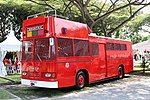Gastronomy in Singapore
EngvarB from January 2019Gastronomy in Singapore

Notable eateries in Singapore are café, coffee shop, convenience stores, fast food restaurant, food courts, hawker centres, restaurant (casual), speciality food shops, and fine dining restaurants. According to Singstat in 2014 there were 6,668 outlets, where 2,426 are considered as sit down places. According to ACRA every day two new restaurants open daily in Singapore.The variety of Singaporean cuisine covers basically all notable ethnic groups and cultures.
Excerpt from the Wikipedia article Gastronomy in Singapore (License: CC BY-SA 3.0, Authors, Images).Gastronomy in Singapore
Tanglin Halt Road, Singapore
Geographical coordinates (GPS) Address Nearby Places Show on map
Geographical coordinates (GPS)
| Latitude | Longitude |
|---|---|
| N 1.3 ° | E 103.8 ° |
Address
New Town Primary School
Tanglin Halt Road 300
148812 Singapore
Singapore
Open on Google Maps






